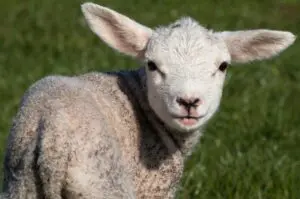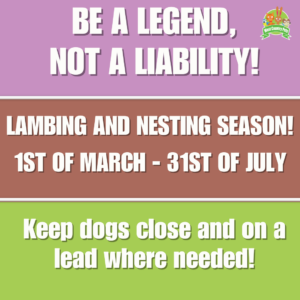Importance of Keeping Dogs Under Control During Lambing and Nesting Season

As spring arrives in the UK, the countryside comes to life with the arrival of newborn lambs and the nesting season for wild birds. While this is a beautiful time of year, it also presents significant risks for livestock and wildlife, especially from dogs that are not kept under control. It is the responsibility of all dog owners to ensure their pets do not disturb or harm animals during this critical period.
Failure to do so can lead to severe consequences, including fines, prosecution, and even the legal right of farmers to shoot dogs that worry livestock. In this article, we will discuss the importance of keeping dogs under control, the laws surrounding this issue, and how dog owners can act responsibly to protect the countryside.
The Dangers of Uncontrolled Dogs and the Importance of Keeping Dogs Under Control
Many dog owners underestimate the damage their pets can cause when left off-lead in rural areas. Dogs have a natural instinct to chase, and even the most obedient dog can suddenly give in to these urges. Yes, even your precious, well-trained angel who “wouldn’t hurt a fly”—because, spoiler alert, they don’t have to physically attack an animal to cause harm.
Livestock Attacks and Stress
During lambing season (typically between January and May), ewes and their newborn lambs are particularly vulnerable. A dog does not need to physically attack a sheep to cause harm. The mere presence of a running dog can result in severe stress, leading to:
- Miscarriages in pregnant ewes
- Fatal exhaustion
- Separation of lambs from their mothers, leaving them exposed to hypothermia and starvation
Even a dog barking or lunging on a lead near livestock can cause distress, leading to panicked reactions and injuries. Just because your dog “doesn’t mean any harm” doesn’t mean the sheep understand that.
If a dog physically attacks or chases sheep, injuries and fatalities are almost inevitable. Farmers report incidents of dogs mauling lambs or causing entire flocks to stampede, leading to devastating losses.
Impact on Nesting Birds
From March to July, many ground-nesting birds, such as skylarks, curlews, and lapwings, lay their eggs in grasslands, moorlands, and farmland. A loose dog running through these areas can trample nests, destroy eggs, or cause parent birds to abandon their young. With many bird populations already in decline, the disturbance caused by uncontrolled dogs further threatens their survival.
The Law and Penalties for Dog Owners
The UK has strict laws in place to protect livestock and wildlife from dog attacks. Dog owners must understand the legal consequences of failing to control their pets.
Livestock Protection Laws
Under the Dogs (Protection of Livestock) Act 1953, if a dog worries livestock (defined as chasing, attacking, or causing distress), the owner can face fines of up to £1,000. In some cases, additional compensation may be required for any damage caused.
Furthermore, the Animals Act 1971 grants farmers the legal right to shoot a dog that is worrying livestock, if there is no other way to stop the attack. This is a last resort, but it is entirely legal, and many owners have tragically lost their pets due to reckless behaviour.

Wildlife Protection Laws
The Wildlife and Countryside Act 1981 makes it illegal to disturb nesting birds or destroy their eggs. If a dog is allowed to disturb a nesting area, the owner could face prosecution, with fines reaching up to £5,000 per offence. This is a great article by the RSPB on ground nesting birds and their habitats
How to Be a Responsible Dog Owner
To protect livestock, wildlife, and avoid legal trouble, dog owners should follow these simple but essential guidelines:
1. Always Keep Dogs on a Lead Near Livestock
Never assume that your dog will ignore sheep, cows, or other farm animals. Even the best-trained dogs can act unpredictably in new situations. If you are walking near fields with livestock, your dog must be on a short lead at all times.
2. Obey Signage and Stick to Footpaths
Farmers often place signs warning about lambing or livestock in fields. These should never be ignored. Stick to designated footpaths and avoid walking through fields with livestock wherever possible.
3. Close Gates Behind You
It might come as a shock to some, but leaving gates open is not just an inconvenience—it can have devastating consequences. Open gates allow livestock to escape onto roads, causing potential accidents and injuries. Always double-check that a gate is properly closed after passing through. If you find a gate open, leave it as you found it unless there is clear signage stating otherwise.
4. Avoid Clearly Marked Nesting Areas
During the nesting season, keep dogs away from areas and open countryside where birds lay their eggs. If you must walk in these areas, keep your dog on a lead and under control, and follow signs.
5. Train Your Dog for Reliable Recall
If you ever allow your dog off-lead in safe areas, they must have a strong recall. Training your dog to come back immediately when called can prevent them from running into dangerous situations. However, even with excellent recall, never let them off-lead near livestock.
6. Pick Up After Your Dog
Dog waste can carry diseases that are harmful to livestock, particularly a parasite called Neospora, which can cause abortions in cattle. Always clean up after your pet and dispose of waste properly.
What Farmers Can Do to Protect Their Livestock
While dog owners must act responsibly, farmers also have options to protect their animals from dog attacks.
1. Install Clear and Visible Signage
Place signs at field entrances and along public footpaths warning dog owners of livestock presence and requesting dogs to be kept on a lead.
2. Secure Livestock Areas
Ensure that fences and gates are well-maintained to prevent dogs from entering fields.
3. Report Incidents to the Police
If a dog attacks livestock, farmers should report it to the police immediately. Under the law, action can be taken against the dog’s owner.
4. Use Surveillance Cameras
CCTV cameras can help identify irresponsible dog owners who allow their pets to chase livestock. This evidence can be used to seek legal action if necessary.
5. Educate the Public
Many dog owners simply do not realise the impact their pets can have. Hosting community meetings or sharing educational materials on social media can help raise awareness and prevent future incidents.
Conclusion: Respecting the Countryside and Its Inhabitants
The British countryside is a shared space that requires mutual respect between landowners, farmers, and the public. While dogs are beloved companions, they are also predators by nature, and their instincts can cause devastation if not controlled.
By keeping dogs on a lead, obeying signs, closing gates, and respecting the rules, owners can prevent distress to livestock, protect vulnerable wildlife, and avoid serious legal consequences.
Key Takeaways:
- Dogs must always be on a lead near livestock.
- Disturbing nesting birds is a criminal offence.
- Dog owners can face fines up to £5,000 for wildlife disturbance.
- Farmers have the legal right to shoot dogs attacking livestock.
- Always close gates to prevent livestock escaping.
- Everyone must respect the countryside to protect animals and avoid legal consequences.
By following these guidelines, we can all enjoy the countryside while ensuring the safety of its most vulnerable inhabitants.

Have you seen our other blogs? Why not have a look at our shop!